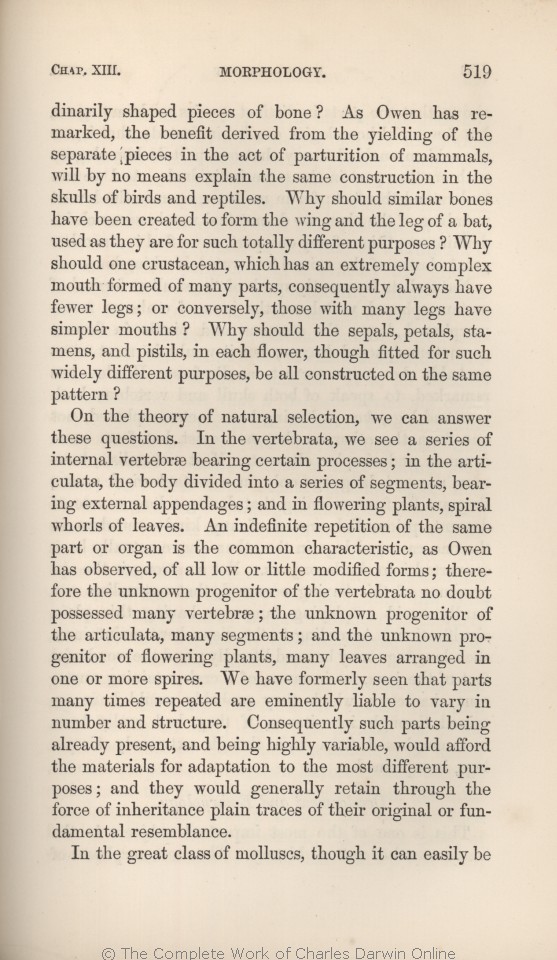shaped pieces of
bone? | bone? 1859 1860 1861 1866 1869 |
| bone, apparently representing vertebræ? 1872 |
| of 1859 1860 1861 1866 1869 | | by 1872 |
| birds and reptiles. 1866 1869 1872 |
| birds. 1859 1860 1861 |
| to form 1869 1872 |
| in the formation of 1859 1860 1861 1866 |
| the leg 1866 1869 1872 | | leg 1859 1860 1861 |
| purposes? 1859 1860 1861 1866 1869 |
| purposes, namely flying and walking? 1872 |
| pistils, 1869 1872 | | pistils 1859 1860 1861 1866 |
| each 1869 1872 | | any individual 1859 1860 1861 1866 |
| widely different 1859 1860 1861 1866 1869 | | distinct 1872 |
|
On the theory of natural selection, we
can | can 1859 1860 1861 1866 1869 | | can, 1872 |
| OMIT 1869 |
| satisfactorily 1859 1860 1861 1866 |
| to a certain extent, 1872 |
| In the vertebrata, we see 1859 1860 1861 1866 1869 |
| We need not here consider how the bodies of some animals first became divided into 1872 |
| internal vertebræ bearing certain processes; in the articulata, the body 1869 |
| internal vertebræ bearing certain processes and appendages; in the articulata, we see the body 1859 1860 1861 1866 |
| segments, or how they became 1872 |
| a series of segments, bearing external appendages; and in flowering plants, spiral whorls of leaves. 1869 |
| a series of segments, bearing external appendages; and in flowering plants, we see a series of successive spiral whorls of leaves. 1859 1860 1861 1866 |
| right and left sides, with corresponding organs, for such questions are almost beyond investigation. 1872 |
| 2 blocks not present in 1859 1860 1861 1866 1869; present in 1872 | | It is, however, probable that some serial structures are the result of cells multiplying by division, entailing the multi- plication of the parts developed from such cells.
It must suffice for our purpose to bear in mind that an indefinite repetition of the same part or organ is the common characteristic, as Owen has remarked, of all low or little specialised forms; therefore the unknown progenitor of the Vertebrata probably possessed many vertebræ; the unknown progenitor of the Articulata, many segments; and the unknown progenitor of flowering plants, many leaves arranged in one or more spires.
|
| characteristic, 1866 1869 | | characteristic 1859 1860 1861 |
| as 1866 1869 | | (as 1859 1860 1861 |
| observed, 1866 1869 | | observed) 1859 1860 1861 |
| little modified 1861 1866 1869 | | little-modified 1859 1860 |
| OMIT 1869 |
| we may readily believe that 1859 1860 1861 1866 |
| no doubt possessed 1869 |
| possessed 1859 1860 1861 1866 |
| leaves arranged in one or more spires. 1869 |
| spiral whorls of leaves. 1859 1860 1861 1866 |
| formerly 1859 1860 1861 1866 1869 | | also formerly 1872 |
| vary 1859 1860 1861 1866 1869 | | vary, 1872 |
| in number and structure. 1869 |
| in number and structure; consequently it is quite probable that natural selection, during a long-continued course of modification, should have seized on a certain number of the primordially similar elements, many times repeated, and have adapted them to the most diverse purposes. 1859 1860 1861 1866 |
| not only in number, but in form. 1872 |
| Consequently 1869 1872 |
| And as the whole amount of modification will have been effected by slight successive steps, we need not wonder at discovering in 1859 1860 1861 |
| And as the whole amount of modification will have been effected by successive slight steps, we need not wonder at discovering in 1866 |
| parts 1859 1860 1861 1866 1869 | | parts, 1872 |
| being already present, and being highly variable, would afford the materials for adaptation to the most different purposes; and they would generally retain through the force 1869 |
| or organs, a certain degree of fundamental resemblance, retained by the strong principle 1859 1860 |
| or organs a certain degree of fundamental resemblance, retained by the strong principle 1861 1866 |
| being already present in considerable numbers, and being highly variable, would naturally afford the materials for adaptation to the most different purposes; yet they would generally retain, through the force 1872 |
| inheritance plain traces of their original or fundamental resemblance. 1869 |
| inheritance. 1859 1860 1861 1866 |
| inheritance, plain traces of their original or fundamental resemblance. 1872 |
| 2 blocks not present in 1859 1860 1861 1866 1869; present in 1872 | | They would retain this resemblance all the more, as the variations, which afforded the basis for their subsequent modification through natural selection, would tend from the first to be similar; the parts being at an early stage of growth alike, and being subjected to nearly the same conditions.
Such parts, whether more or less modified, unless their common origin became wholly obscure, would be serially homologous.
|
|









